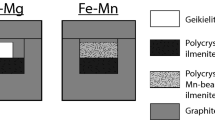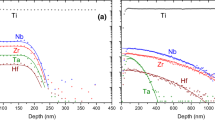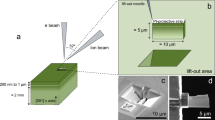Abstract
Few diffusion coefficient values have been measured for silicate minerals at pertinent geologic conditions because of experimental restrictions. Until recently, analysis of diffusion couples was conducted principally with electron microprobes which have rather poor spatial resolution (micrometer scale). Ion microprobe analyses, however, eliminate many of the previous experimental restrictions; in depth profile mode they have excellent spatial resolution (tens of angstroms) and diffusion couples can be analyzed normal to the interface. Diffusion couples analyzed by ion microprobe must be well-defined and uniform; previous methods using solution precipitates to form the diffusion couples were heterogeneous and had limited success. A new approach, the thermal evaporation of25MgO under high vacuum onto a crystalline substrate (oxide, silicate), produces a 1000 Å thick25MgO x (x<1) thin film. This method yields an excellent diffusion couple for low-temperature diffusion experiments. Diffusion anneal experiments using this approach for garnet provide a Mg self-diffusion coefficient ofD=0.60±0.09×10−21 m2/s at 1000°C (logFO2=−11.3,P=1 atm,X Almandine=0.24).
Similar content being viewed by others
References
Buening, D. K., andBuseck, P. R. (1973),Fe−Mg Lattice Diffusion in Olivine, J. Geophys. Res.78, 6852–6862.
Chakraborty, S., andGanguly, J. (1992),Cation Diffusion in Aluminosilicate Garnets: Experimental Determination in Spessartine-almandine Diffusion Couples, Evaluation of Effective Binary Diffusion Coefficients, and Applications, Contributions to Mineralogy and Petrology111, 74–86.
Chakraborty, S., Rubie, D. C., andElphick, S. C. (1992),Mg Tracer Diffusion in Aluminosilicate Garnets at 800°C, 1 Atm. and 1300°C, 8.5 GPa, Trans. Am. Geophys. Union, EOS73, 43, 567.
Crank, J.,The Mathematics of Diffusion (Oxford University Press, Oxford 1975).
Cygan, R. T., andLasaga, A. C. (1985),Self-diffusion of Magnesium in Garnet at 750° to 900°C, Am. J. Science285, 328–350.
Elphick, S. C., Ganguly, J., andLoomis, T. P. (1985),Experimental Determination of Cation Diffusivities in Aluminosilicate Garnets: Experimental Methods and Interdiffusion Data, Contributions to Mineralogy and Petrology90, 36–44.
Freer, R. (1979),An Experimental Measurement of Cation Diffusion in Almandine Garnet, Nature280, 220–222.
Freer, R. (1981),Diffusion in Silicate Minerals and Glasses: A Data Digest and Guide to the Literature, Contributions to Mineralogy and Petrology76, 440–454.
George, J.,Preparation of Thin Films (Marcel Dekker, New York 1992).
Houlier, B., Cheraghmakani, M., andJaoul, O. (1990),Silicon Diffusion in San Carlos Olivine, Phys. Earth Planet. Int.62, 329–340.
Jaoul, O., Poumellec, M., Froidevaux, C., andHavette, A.,Silicon diffusion in forsterite: A new constraint for understanding mantle deformation, InAnelasticity in the Earth (eds. Stacey, F. D., and Paterson, M. S.) (American Geophysical Union, Geodynamics Series, Volume 4, 1981) pp. 95–100.
King, B. V.,Sputter depth profiling, InSurface Analysis Methods in Materials Science (eds. O'Connor, D. J., Sexton, B. A., and Smart, R. St. C.) (Springer Verlag, Berlin 1992) pp. 97–116.
Ohring, M. The Materials Science of Thin Films (Academic Press, San Diego 1992).
Ryerson, F. J., Durham, W. B., Cherniak, D. J., andLanford, W. A. (1989),Oxygen Diffusion in Olivine: Effect of Oxygen Fugacity and Implications for Creep, J. Geophys. Res.94, 4105–4118.
Surdashan, T. S.,Surface Modification Technologies: An Engineers Guide (Marcel Dekker, New York 1989).
Tannhauser, D. S. (1956),Concerning a Systematic Error in Measuring Diffusion Constants, J. Appl. Phys.27, 662.
Wilson, R. G., Stfvie, F. A., andMagee, C. W.,Secondary Ion Mass Spectrometry: A Practical Handbook for Depth Profiling and Bulk Impurity Analysis (J. Wiley and Sons, New York 1989).
Author information
Authors and Affiliations
Rights and permissions
About this article
Cite this article
Schwandt, C.S., Cygan, R.T. & Westrich, H.R. A thin film approach for producing mineral diffusion couples. PAGEOPH 141, 631–642 (1993). https://doi.org/10.1007/BF00998349
Received:
Revised:
Accepted:
Issue Date:
DOI: https://doi.org/10.1007/BF00998349




